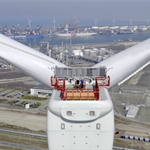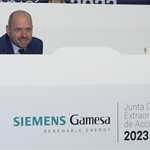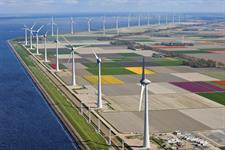Analysis: Why did Siemens Gamesa and GE settle their legal battle?
Energy Disrupter
The rival turbine manufacturers’ bitter global patent dispute, conducted across multiple markets, had been rumbling along for years.
But the end, when it came, was sudden and surprisingly low-key. A simple statement, agreed by both sides and issued on a Friday afternoon without much fanfare, considering the millions of dollars spent by both OEMS fighting the case in multiple jurisdictions.
Agreed terms
According to the statement, released by GE, both sides in the dispute have “reached an amicable settlement of all their wind turbine technology patent disputes in the United States and Europe on confidential terms and have granted each other and their respective subsidiaries worldwide cross licences under the asserted patent families, for the life of those patent families”.
To those on the outside, the sudden “amicability” of both parties must seem baffling. After all, Siemens Gamesa appeared to have the stronger hand in the patent battle over GE’s disputed Haliade-X turbine, having won its case in a US court last year.
A court hearing in February at the US District Court in Massachusetts to decide the royalties GE must pay to Siemens Gamesa found that the former must pay the latter $60,000/MW for turbines installed at the Ocean Wind 1 project off the coast of New Jersey and $30,000/MW for turbines installed at the Vineyard Wind 1 project.
Why did they settle?
The judge’s decision on royalties in the hearing makes Siemens Gamesa’s decision to settle the case all the more perplexing, despite the turbine firm losing a similar case in November when a judge in the UK’s High Court ruled against it.
So why did the warring parties call a truce?
Paul Morico, sector chair of intellectual property at the Baker Botts law firm in Houston, told Windpower Monthly that Siemens Gamesa and GE had made a decision that would benefit both.
He said: “Both companies will be saving a lot of money on attorneys’ fees now that these cases have settled. Global patent disputes are expensive and draining on a company’s resources.”
Morico added: “They also tend to tie up funds which have to be held in escrow that could be used for future research and development and other business development.”

Fellow intellectual property specialist Jared Hoggan (above), a patent litigator and partner at the Munck Wilson Mandala law firm in Dallas, said the settlement showed the turbine firms had found common ground regarding the value of their patent portfolios and had agreed to licence their respective technology in a “mutually beneficial” agreement.
Hoggan added: “Patent litigation is expensive and time-consuming and can create significant risk uncertainty to a company. By settling, each party can now refocus its time, energy and resources on its core business.”
Both parties had also significantly reduced the risk of future patent disputes by “cross-licensing the asserted patent families on a worldwide basis,” said Hoggan.
Plague on both your houses
While giving his decision on the amount of royalties GE should pay at the February hearing in Boston, Massachusetts, presiding judge William Young delivered a second verdict that amounted to a stinging rebuke to the reputation and behaviour of both turbine firms in the dispute.

Judge Young (above) told them: “This struggle does nothing to advance the public interest of the people of the United States or any other nation. Indeed, it inhibits efforts to combat climate change world-wide. It would be far, far better for these two corporate behemoths – consistent with antitrust requirements – to cross-license their particular technological contributions and forge ahead with production in the global public interest.”
Thus chastised by judge Young, did Siemens Gamesa and GE decide to settle their differences for a greater good, or at least to preserve their reputations as companies capable of delivering a benefit for the planet?
Morico said: “I’m sure this had some impact on their decision to resolve their dispute. In my experience companies get fatigued with these global worldwide extended patent disputes.”
Morico added that long-running patent cases almost always end with the issuing of cross-licences.
He added: “There is a realisation at one point that nobody is going to win these battles where both companies have patents to assert against either other. The judge’s admonition likely hastened this realisation for both companies.”
What was in the confidential agreement?
The terms of the agreement have been kept under wraps by both sides but what could GE and Siemens Gamesa have offered each other to resolve the dispute?
We are unlikely to ever know for certain, but, asked to speculate, Morico said the settlement most likely involved a cross-license of all current patents in both companies’ portfolios covering existing technology and, likely, future patents claiming priority, “i.e., stemming from such patents”.
He added: “It likely excluded future-developed technology and patents. This would allow both companies to sell their existing products without fear of suit or injunction. There may have been a payment of money from one of the companies to the other as often happens in these kinds of cases.”
Industry sigh of relief?
The patent dispute had wider ramifications than the financial health of the immediate litigants, of course: developers and others in the wind industry were holding their collective breath too, as the financial viability of projects already in the pipeline was threatened.
So how will the wider wind industry benefit from the end of the long-running dispute?
Hoggan said: “I believe this settlement promotes continued innovation and competition in the wind industry. The parties have shown the importance and value of protecting and licensing intellectual property.”
Developers and investors may also be breathing a sigh of relief that the dispute has been resolved.
Morico said: “I would expect there to be a lot more projects moving forward with these cases settled. The concern that a project may get shut down likely had a significant quelling effect on future projects –nobody wants to invest in a project that may get shut down.”
There is also a wider benefit to the public that is now set to benefit from the technologies that both companies can offer.
Morico said: “The public will be the clear winner in that it will have access to both companies’ technologies at a competitive price.”
He added: “Wind power is an important component of the world’s transition to renewable, clean energy and it’s important to us all that this technology continues to be implemented on a wide-scale.”
















